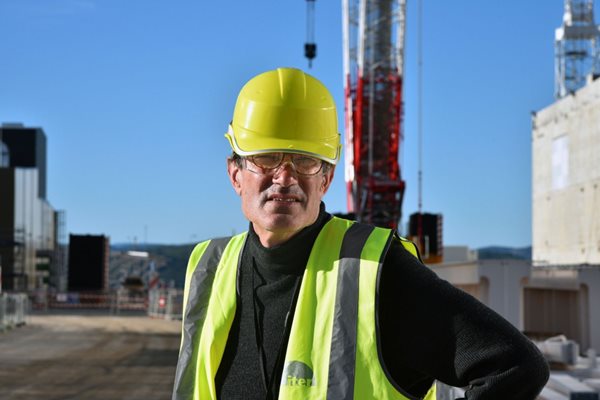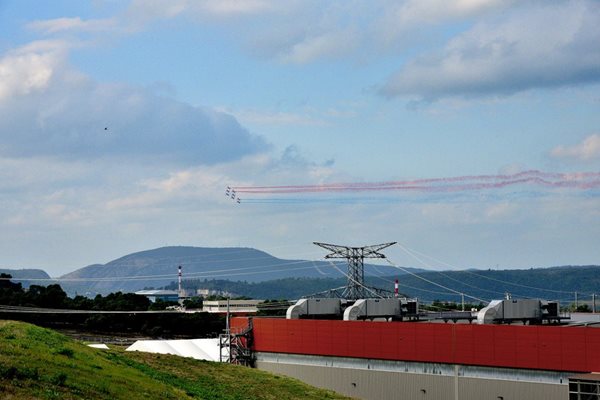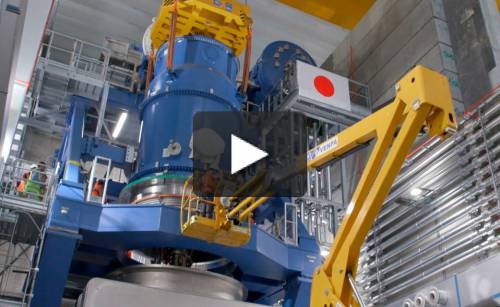
you're currently reading the news digest published from 07 Oct 2019 to 14 Oct 2019
featured5
of-interest1
video1
press6
featured
Challenges | Managing risk in a first-of-a-kind project
The classic approach to project management is to group risks into three separate categories. The first consists of known risks, the second of unknown risks, and the third of unknowable risks, often referred to as the 'unknown unknowns.' This approach of classifying risks is used on most large projects—and ITER is no exception. The easiest risks to manage are the known risks. When you have managed a project before, you know from experience what can go wrong. You know what to do to head the risks off early, and you know how to minimize damage if they do occur. When you are running a first-of-a-kind project, however, many of the risks initially fall into the unknown category. While you can identify them, you may not immediately know how to mitigate them. But with further research about how others have solved similar problems, many of the unknown risks can be promoted to the known category. The toughest risks to manage are the unknowable—the ones you cannot even identify. The classic approach for dealing with unknown unknowns is to put a lot of schedule or budget contingencies into the project from the beginning—providing slack that can be taken up as the inevitable surprises occur. A first-of-a-kind project with no initial contingencies 'There was a debate about contingencies among the ITER Members,' says Hans-Henrich Altfeld, Head of the Project Control Office at ITER. 'Some Members insisted on having contingencies, because in their view it's good project management practice to do so, particularly for first-of-a-kind projects. Other Members took the position that if you put a contingency into a budget or a schedule, you can be certain it will be consumed. These differences in perspective are in part cultural, and the type of challenge that comes with international project management.' In the end, the decision was made to include no contingency, thereby assuming that all major risks can be mitigated. This is how ITER began on a first-time-right assumption, with no initial cost or schedule contingencies. Over time however, the Project Control Office hopes to build up contingencies by looking for opportunities to generate savings in time or money to create some of the slack that will be needed to handle surprises. 'We look particularly at parallelizing work,' says Altfeld. 'But often when you do this, you also introduce additional technological risks. There is always a price to pay. It requires judgment in the end.' A variety of level-one risks at ITER At ITER, risk management is carried out using a classic approach, where risks are identified, assessed and prioritized. Project actors may come forward with risks, or the risk management team may identify risks by asking challenging questions. But regardless of how they are spotted, for each of the important risks, the project management office develops a mitigation strategy and reviews both risks and mitigation strategies on a regular basis. 'Our way of ranking risks is pretty standard, with one exception,' says Altfeld, who arrived at to ITER three years ago with 30 years of program and project management experience, including a 23-year stint at Airbus. 'The exception is that we factor in the impact a risk might have on schedule. In particular, we rank a risk higher if it could lead to an issue on the critical path. For the time being, the critical path is the path that leads to First Plasma, our major milestone in 2025.' The project management team pays very close attention to risks with the highest rankings. One of the top risks in ITER's register, for example, is that one or more of the seven signatories to the ITER Agreement do not pay their complete cooperation. Other high-level risks are technical, and are very well known in the tokamak environment—for example, leakages to the vacuum. 'There is so much welding going on to create the actual torus, and all the pipes which bring the liquid helium and the water and the gases and so on, that if one weld is not perfect, there could be enough leakage to destroy the performance of the tokamak,' says Altfeld. Another top risk shared with all large projects is losing control of the data you need to generate along the lifecycle of the project, or losing track of configurations. 'We need to always know where we stand technically, and particularly at the interface between engineering and construction,' says Altfeld. 'That interface is critical. The construction teams can only build what was designed up front. The data must be accurate and complete.' The failure, for whatever reason, of the Domestic Agencies to provide their in-kind components on time, and on quality, is another major risk. This risk is always present when a supply chain is involved. But on the ITER Project, this risk is particularly pronounced, says Altfeld. 'A big corporation, such as Airbus, gets a lot of components from suppliers. Something could go wrong, of course. But Airbus has financial leverage to mitigate the problem because it has those suppliers under direct contract. The ITER Organization does not have that kind of leverage with the Domestic Agencies.' Conservatively optimistic Altfeld says that ITER is comparable to building the A380, the biggest Airbus. The two projects are of about the same financial value; they are also similar in terms of complexity. He also compares ITER to the International Space Station (ISS) project which, like ITER, started with a large number of unknowable risks. 'While there were many surprises requiring extra money and time, the ISS was successful in the end, and it has been operating for a long time.' 'Yes, there are risks with ITER,' says Altfeld, 'especially given the first-of-a-kind nature of the project. But is it beyond imagination? No. Are we confident that we can manage those risks in a way that the objectives of the ITER Project can be met? The answer is clearly yes. We are conservatively optimistic, because we know we are doing our homework well.'
Steve Cowley | Projecting into the coming decades
Steven Cowley, who now heads the Princeton Plasma Physics Laboratory (PPPL), gave a seminar last week at CEA-Cadarache and he had some good news regarding the spherical tokamak NSTX. An offshoot of the conventional tokamak design, the National Spherical Torus Experiment was built in the late 1990s by PPPL in collaboration with the Oak Ridge National Laboratory, Columbia University, and the University of Washington at Seattle. The machine produced its first plasma in February 1999 and operated until 2012. It was upgraded into NSTX-U between 2012 and 2015, gaining a more powerful toroidal field (1 T), plasma current (2 MA) and heating system. 'This is not a little spherical torus anymore,' said the head of engineering and operations at the time. 'This machine has 10 times the capability of the original NSTX.' In 2016 however, as NSTX-U was ten weeks into operations, a dysfunction in one of its poloidal field coils brought everything to a halt. Following the complete dismantling of the reactor and coils, a new team set to work and by last week a new baseline was finalized. 'We now have an early finish date in April 2021,' said Cowley to the CEA audience. 'The spherical tokamak will be back around that time ...' Cowley did not come to CEA (and to ITER following his conference) just to provide an update of Princeton's spherical tokamak, however. Titled 'Pilot plans and simplifying stellarators,' his presentation dwelt on the roadmapping of fusion in the US ('like EUROfusion has done successfully') and the exploration of the role that 'faster and cheaper' devices—whether bigger or smaller—could play in the pursuit of a pilot plant. In this projection into the coming decades (the US National Academy of Science is pushing for an operational pilot plant in the 2040s), a new breed of stellarators could play a central role. 'Making net electricity is easier in a stellarator,' explained the head of PPPL, and innovations such as simplified coils, permanent magnets and toroidal field coils insulated in individual cryostats are options worthy of consideration. In this perspective, the experience that PPPL accumulated in designing and manufacturing parts for the Quasi Axisymmetric (QAS) National Compact Stellarator Experiment (NCSX) in the 1990s would be highly valuable. Although budgetary considerations led to a cancellation of NCSX in 2008, QAS stands as an important concept on an 'uncompleted pathway to fusion'—one that new projects could tread again in the near future.
Outreach | What vacuum does to marshmallows
Every year in France, science is "à la fête" for two consecutive weekends in October. Free events and demonstrations—tailored particularly to school-age children—offer a fun and friendly way to discover projects like ITER. Ask any one of the ITER guides and they will tell you: the marshmallows are the biggest draw. Demonstrating the concept of vacuum by showing children what happens to a marshmallow when air is pumped out of a sealed chamber or, on the contrary, pumped back in never fails to delight. (Especially when the results of the experiment are passed around for tasting.) For the 2019 edition of France's Festival of Science (Fête de la Science), ITER brought its displays to four localities: Manosque, Aix-en-Provence, Marseille, and Villeneuve-Loubet (near Nice). Dozens of bags of marshmallows, boxes of T-shirts and brochures, a microwave to demonstrate the creation of plasma, devices to demonstrate magnetism and vacuum, and 18 volunteers were dispatched for three-day events on the first two weekends of October. ITER Communication's Julie Marcillat and Ruxandra Pilsiu coordinated all events. With over 14,000 people attending, including 4,000 school children, and long lines at the ITER stands, the outreach effort can be considered a success.
Physics | 11th ITER International School announced
The 11th ITER International School will be held from 20 to 24 July 2020, hosted by Aix-Marseille University in Aix-en-Provence, France. The subject of this year's school is 'The Impact and Consequences of Energetic Particles on Fusion Plasmas.' As the start of ITER operations approaches, it is timely to address this multidisciplinary topic that includes plasma self-heating by fusion-born alpha-particles, the influence of energetic particles on stability, diagnosing energetic particle transport and loss, and understanding runaway electrons. The ITER International School aims to prepare young scientists and engineers for working in the field of nuclear fusion and in research applications associated with the ITER Project. The adoption of a 'school' format was a consequence of the need to prepare future scientists and engineers on a range of different subjects and to provide them with a wide overview of the interdisciplinary skills required by ITER. The first ITER School was organized in Aix-en-Provence, France, in July 2007 and focused on turbulent transport in fusion plasmas. Nine successive schools have followed on a variety of subjects: magnetic confinement (Fukuoka, Japan, 2008); plasma-surface interactions (Aix-en-Provence, 2009); magneto-hydro-dynamics and plasma control (Austin, Texas (US), 2010); energetic particles (Aix-en-Provence, 2011); radio-frequency heating (Ahmedabad, India, 2012); high performance computing in fusion science (Aix-en-Provence, 2014); transport and pedestal physics in tokamaks (Hefei, China, 2016); physics of disruptions and control (Aix-en-Provence, 2017); and the physics and technology of power flux handling (Daejeon, Korea, 2019). Further information on the 2020 school will be available from the beginning of November at https://iis2020.sciencesconf.org. Find out more about past schools here.
Image of the week | An anniversary in blue, white and red
ITER neighbour and close partner in fusion research, the CEA-Cadarache nuclear research centre, was established in October 1959. This week, it celebrated the 60th anniversary of its creation. On Monday, the Patrouille de France, the aerobatic demonstration unit of the French Air Force (established in 1953), paid a quick visit to the site, inscribing the autumn sky with its signature plume of blue, white and red smoke. On its way back to its base in Salon-de-Provence, 75 kilometres to the west, the Patrouille flew past ITER, giving the moment a feeling of Bastille Day.
of-interest
In a small corner of Haute-Provence
In a few decades, when dozen of fusion plants operate throughout the world and the first signs of alien life are detected in a faraway system, one will realize that it all started here, in a small corner of southern France, amidst the rolling hills of Haute-Provence. The ITER site and the Observatoire de Haute-Provence are only 45 kilometres distant. In 1995, two Swiss astronomers, Michel Mayor and Didier Queloz, coupled a highly sophisticated spectroscope to the Observatory's old 1.93-metre telescope (it was installed in 1958!) and discovered the first exoplanet—a 'hot Jupiter' body orbiting the sun-like star 51 Pegasi, 42 light years distant from the Earth. Last week, both Mayor and Queloz (along with astrophysicist James Peebles) were awarded the Nobel Prize in Physics for 'forever changing our conceptions of the world.' By the time the first ITER buildings were coming out of the ground, close to 1,000 exoplanets had been detected. As of today, their number exceeds 4,500. Some of these worlds, made of solid rock like Earth, are orbiting the 'habitable zone' of their star, where temperature allows water to be liquid and where life, whatever its form, is a possibility. At an interval of a few years, on the ITER site and at the Observatoire de Haute-Provence, the seeds were sown for two momentous, game-changing pursuits: the harnessing of fusion energy and the quest for life outside our solar system.






